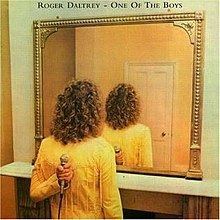Released 13 May 1977 Release date 13 May 1977 | Length 39:19 Label MCA Records | |
 | ||
Recorded November 1976-March 1977 Similar Roger Daltrey albums, Rock music albums | ||
One of the boys roger daltrey
One of the Boys is the third studio solo album by the Who's lead vocalist, Roger Daltrey. It was first released in 1977, on Polydor in the UK, and MCA in the US. The sessions were recorded at the Who's Ramport Studios during the winter of 1976 (vocals were recorded at Pathe Marconi Studios in Paris, due to tax complications), and Daltrey allowed students from the local Battersea technical school to film them as an educational project. This also marked the first time that Daltrey had written or co-written a song since "Here For More" (released as the B-side of the Who's "The Seeker") in 1970, and Lisztomania in 1975. Daltrey's original choice for producers were Jerry Leiber and Mike Stoller, but they declined.
Contents
- One of the boys roger daltrey
- One of the boys roger daltrey album top 8 facts
- Album cover art
- Tracks background
- Critical reception
- Personnel
- Sales chart performance
- Songs
- References
When Leo Sayer launched his own career as an artist, Daltrey called on a widening group of friends to write for and perform on his albums. Paul McCartney contributed the new song "Giddy" to One of the Boys, where the band included Hank B. Marvin of the Shadows, Eric Clapton of Cream, Alvin Lee and Mick Ronson, as well as calling two members of the Who, John Entwistle and Keith Moon.
Daltrey embraced punk rock on this album, and later appeared in public with safety pins through his nose (a trend of the punk movement).
One of the boys roger daltrey album top 8 facts
Album cover art
On this cover, after releasing Ride a Rock Horse with Daltrey as a rampant centaur another visual trick is played with Daltrey's mirror image, with reference to Magritte's famous painting Reproduction Interdite, photographed and designed by Daltrey's cousin Graham Hughes
The album cover art depicts Daltrey standing in front of a mirror, Daltrey can see only the back of his head.
Tracks background
Parade, is a covered song originally released on Phillip Goodhand-Tait's sixth solo album Teaching an Old Dog New Tricks, in 1976.
Single Man's Dilemma, is a song written by Colin Blunstone for Daltrey, Blunstone is the lead vocalist for The Zombies.
Avenging Annie, is a covered track originally released on Andy Pratt's debut solo album Andy Pratt, in 1973, The song was released as a single (By Daltrey) in October 1977, the song reached #88 in the US, but was not released in the UK.
Leon, is a song written and recorded by Phillip Goodhand-Tait in 1977, but wasn't released by Goodhand-Tait until 2011, on Radio Songs: 1977 Recordings from Radio Bremen, the song was released as a single (By Daltrey) in April 1978 but did not chart and was not released in the UK.
One of the Boys, is a song written by Steve Gibbons about Daltrey, Gibbons did his own version live in 1977, and was released on his live album, Caught in the Act, the song was released as a single (by Daltrey) in June 1977 but did not chart, the song was not released in the US.
Giddy is a song written by the Beatles' bassist, Paul McCartney for Daltrey, The song started off as a demo called "Rode All Night", the refrain was later incorporated into "Giddy".
Written on the Wind is a song written by Paul Korda for Daltrey, the song features Korda playing piano, the song was released as a single in April 1977, it reached #46 in the UK, but was not released in the US.
Say It Ain't So, Joe, is a covered track originally released on Murray Head's second solo album Say It Ain't So in 1975, the song was released as a single (By Daltrey) in July 1977 but did not chart, the song was not released in the UK, the song was re-released in February 1978 with a different b-side.
Critical reception
Writing for AllMusic, critic William Ruhlmann said that "Roger Daltrey called on a wider circle of friends for his third album and came up with a more varied collection of songs ... But Daltrey was never in danger of getting lost in the all-star session. Nevertheless, the album was not treated as a major release and found only modest commercial success."
Personnel
Sales chart performance
Album
Songs
1Parade3:43
2Single Man's Dilemma3:03
3Avenging Annie4:31
